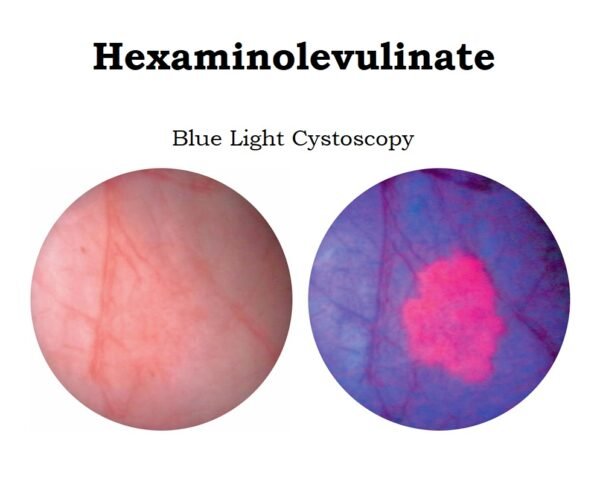Hexaminolevulinate (Cysview) is a precursor of photoactive porphyrin that has got photodynamic properties. Blue-light cystoscopy allows for its visualization as it gathers in the tumor cells.
Uses:
-
Detection of bladder cancer:
- Patients with: may utilize it as an imaging method to find bladder cancer, particularly CIS (carcinoma in situ).
- In individuals having surveillance cystoscopy for bladder cancer, lesions that are known or suspected based on the results of the prior cystoscopy may be present.
- When using the Karl Storz D-Light C Photodynamic Diagnostic (PDD) equipment to perform blue light cystoscopy, hexaminolevulinate solution is utilized as a supplement to the white light cystoscopy (BLC).
- Patients with: may utilize it as an imaging method to find bladder cancer, particularly CIS (carcinoma in situ).
-
Limitations of use:
- It should not be used as a replacement for tissue biopsies that are used to detect bladder cancers.
Hexaminolevulinate Dose in Adults
Hexaminolevulinate Dose in the Detection of bladder cancer:
-
Intravesical instillation:
- A urinary catheter is used to provide 100 mg, which is equal to 50 mL, 1 to 3 hours before to the surgery.
Use in Children:
Not indicated. The safety and efficacy in children are not established.
Pregnancy Risk Category: C
- It has not yet been tested in human pregnancies.
- The drug is not instilled into the bladder and systemic absorption occurs so exposure to the fetus should be minimal.
Hexaminolevulinate use during breastfeeding:
- It is unknown if the drug will be excreted into breast milk.
- The risk of systemic absorption is low. Manufacturers recommend weighing the risks to the infant from drug exposure and the benefits of diagnostic imaging for the mother.
Cysview Dose in Kidney Disease:
The manufacturer has not recommended any dose adjustment in patients with kidney disease.
Cysview Dose in Liver Disease:
The manufacturer has not recommended any adjustments in the dose.
Side Effects of Hexaminolevulinate (Cysview):
-
Central Nervous System:
- Headache
- Procedural Pain
-
Genitourinary:
- Bladder Spasm
- Bladder Pain
- Dysuria
- Hematuria
Contraindications to Hexaminolevulinate (Cysview):
- Allergy reactions to hexaminolevulinate or any derivative of aminolevulinic acids, or any component in the formulation
- porphyria
- Gross hematuria
Warnings and precautions
-
Hypersensitivity
- After the administration of the drug, allergic reactions such as anaphylaxis or anaphylactic shock can occur.
- The procedure site should immediately provide treatment for anaphylactic reactions.
Hexaminolevulinate: Drug Interaction
|
Risk Factor X (Avoid combination) |
|
|
BCG (Intravesical) |
May diminish the diagnostic effect of Hexaminolevulinate. |
Hexaminolevulinate: Drug Interaction
|
Risk Factor X (Avoid combination) |
|
|
BCG (Intravesical) |
May diminish the diagnostic effect of Hexaminolevulinate. |
Monitoring parameters:
Monitor for allergic reactions.
How to administer Hexaminolevulinate (Cysview)?
Intravesical instillation:
- 50 ml of the fluid should be progressively infused through a bladder catheter into the drained urine bladder.
- A lure lock adapter requires a proximal funnel aperture on the bladder catheter.
- Catheters that are vinyl (coated in hydrogel or uncoated), amber or red-colored latex, or silicone catheters may be used for the instillation of the solution.
- Catheters that are embedded with silver or coated with antibiotics should not be used.
- If they are put in just before the surgery and taken out after the medicine is administered, indwelling catheters like foley's catheters may be utilized.
- After the instillation of the solution, instruct the patient not to void for one to three hours (so as to retain the solution). The maximum time to retain it is 3 hours.
- During this time the patient may stand, sit, or move around.
- The solution is evacuated immediately before the cystoscopic procedure.
- After evacuating the bladder, the perineal skin should be washed with soap and water and dried. The solution should not come in contact with the drug.
- The cystoscopic procedure should be performed within 30 minutes of evacuating the bladder (the procedure should not be performed after 3 hours of evacuating the bladder).
Mechanism of action of Hexaminolevulinate (Cysview):
- It is an ester that penetrates the bladder epithelial cells as a precursor to aminolevulinic acids.
- In neoplastic cells, it preferentially generates photoactive intermediate porphyrin IX (PpIX) and other photoactive porphyrins.
- The Karl Storz D-Light Photodynamic Diagnostic (PDD), which employs white and blue light, can be used for cystoscopy.
- Malignant lesions can be seen using PpIX fluorescence light. The fluorescence coming from cancerous tissue is intense and distinct.
Bioavailability:
- 7% when administered into the bladder.
Half-life elimination is biphasic:
- Initial: 39 minutes;
- Terminal: about 76 hours
International Brands of Hexaminolevulinate:
- Cysview
- Hexvix
Hexaminolevulinate Brand Names in Pakistan:
No Brands Available in Pakistan.







